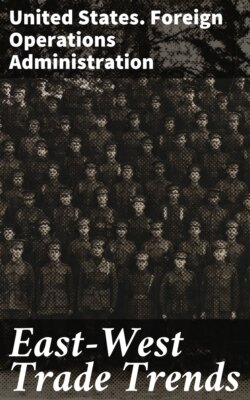Читать книгу East-West Trade Trends - United States. Foreign Operations Administration - Страница 13
Malenkov’s Big Announcement
ОглавлениеThe new economic course for the U.S.S.R. itself was unfolded in three major speeches during the second half of 1953—by Malenkov in August, Khrushchev in September, and Mikoyan in October—and in a series of decrees and lesser pronouncements.
Premier Malenkov, addressing the Supreme Soviet on August 8, made repeated claims of Soviet strength and progress. For example, he said the United States had no monopoly on the hydrogen bomb and added that such facts “are shattering the wagging of tongues about the weakness of the Soviet Union.” But in the section on consumer goods he gave a revealing picture of weakness.
He spoke at great length about lags and failures in agriculture and in the manufacture of consumer articles. He severely criticized the poor quality and appearance of goods, the “serious shortcomings” in the organization of domestic trade, the “unsatisfactory leadership of enterprises,” the “high production costs” and high prices of coal and timber, the “neglected state” of agriculture in many districts, the “serious lagging” in livestock, potatoes, and vegetables. He said the Government considered it “essential to increase considerably” the investment in consumer industries.
The urgent task [Malenkov said] lies in raising sharply in 2 or 3 years the population’s supply of foodstuffs and manufactured goods, meat and meat produce, fish and fish produce, butter, sugar, confectionery, textiles, garments, footwear, crockery, furniture and other cultural and household goods; in raising considerably the supply to the population of all kinds of consumer goods.
The program was to be accomplished in “2 or 3 years,” and this was later repeated in other official statements. In other words it was to be a relatively short-term program of expansion, hardly long enough to make a major shift in industrial emphasis—nor did Malenkov claim such a shift. He said, “We shall continue to develop, by all possible means, heavy industry and transport.... We must always remember that heavy industry constitutes the basic foundation of our socialist economy, because without its development, it is impossible to insure further growth of light industry, increase productivity of agriculture, and the strengthening of the defensive power of our country.” Taking up this theme, the Communist propagandists in the U.S.S.R. and the satellites have constantly assured the people that they should not interpret the “present tasks of the economic policy as a retreat from the Marxist-Leninist principles of building up socialism.” The continued growth of basic industries was declared to be essential.
The assertion was made, not that the consumer program would displace basic industrialization, but that both could progress simultaneously. Malenkov said that heavy industry had risen from 34 percent of the total industrial output in 1924-25 to 70 percent in 1953. And while that was going on, he said, the U.S.S.R. was unable to develop light industry (textiles, garments, shoes) and the food industry at the same rate as heavy industry. But now, he said, the Nation was at last able to develop those industries rapidly.
This “now-we-are-strong-enough” theme runs all through the Communist propaganda on the subject. But it doesn’t harmonize with existing facts and figures.
In the first place, though the Soviet Union has made large industrial gains, it has not built its industrial base anywhere near the long-term goals that Stalin set in 1946 for the ensuing 15 years or so—goals which, even if attained, would not bring the U.S.S.R. in most respects to the production levels which the United States has already reached.
In the second place, the “now-we-are-strong” theme seems to leave out of account the truly deplorable condition of Soviet agriculture. Malenkov himself said a drastic increase in consumer goods could not be achieved without “further development and upsurge” of agriculture, because agriculture “supplies the population with food and light industry with raw materials.”
